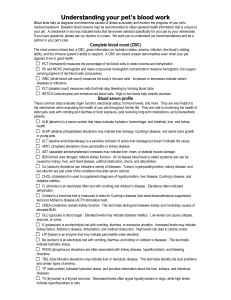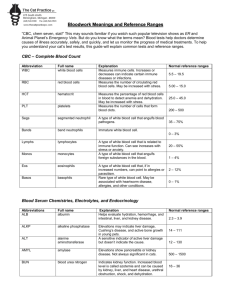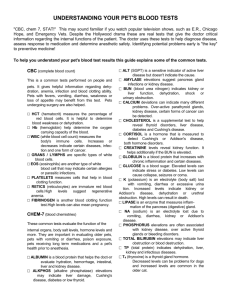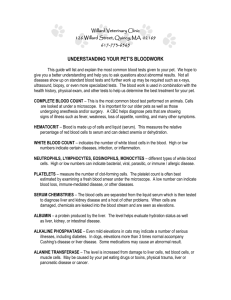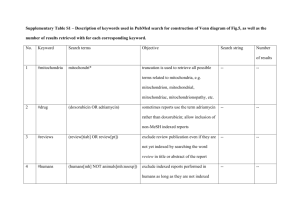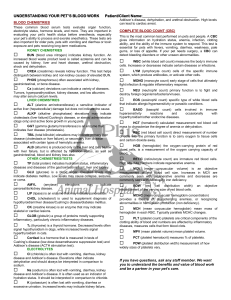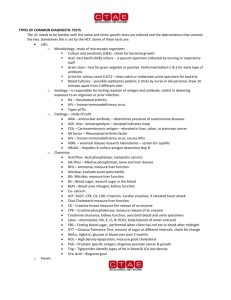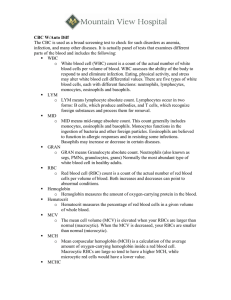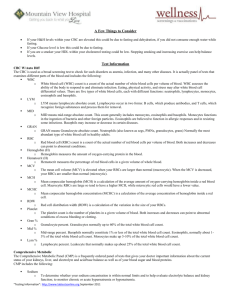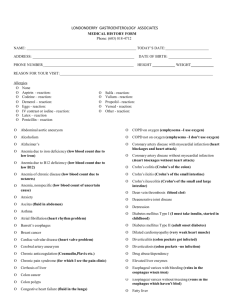& Print Form - Cleveland Veterinary Clinic
advertisement
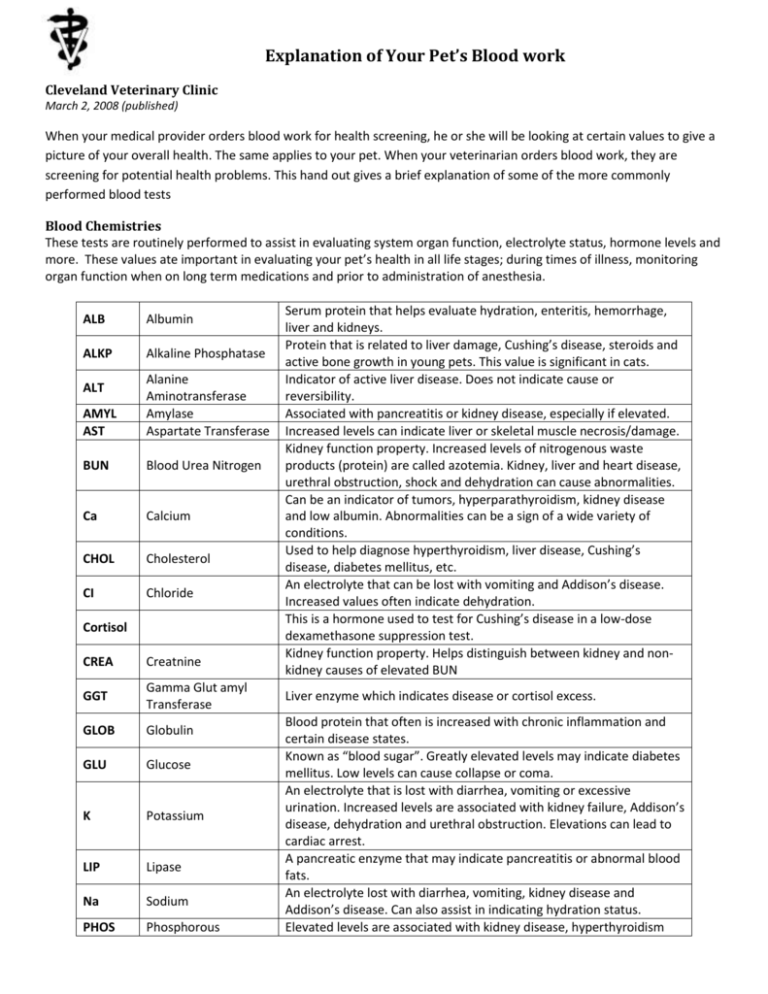
Explanation of Your Pet’s Blood work Cleveland Veterinary Clinic March 2, 2008 (published) When your medical provider orders blood work for health screening, he or she will be looking at certain values to give a picture of your overall health. The same applies to your pet. When your veterinarian orders blood work, they are screening for potential health problems. This hand out gives a brief explanation of some of the more commonly performed blood tests Blood Chemistries These tests are routinely performed to assist in evaluating system organ function, electrolyte status, hormone levels and more. These values ate important in evaluating your pet’s health in all life stages; during times of illness, monitoring organ function when on long term medications and prior to administration of anesthesia. ALB Albumin ALKP Alkaline Phosphatase AMYL AST Alanine Aminotransferase Amylase Aspartate Transferase BUN Blood Urea Nitrogen Ca Calcium CHOL Cholesterol CI Chloride ALT Cortisol CREA Creatnine GGT Gamma Glut amyl Transferase GLOB Globulin GLU Glucose K Potassium LIP Lipase Na Sodium PHOS Phosphorous Serum protein that helps evaluate hydration, enteritis, hemorrhage, liver and kidneys. Protein that is related to liver damage, Cushing’s disease, steroids and active bone growth in young pets. This value is significant in cats. Indicator of active liver disease. Does not indicate cause or reversibility. Associated with pancreatitis or kidney disease, especially if elevated. Increased levels can indicate liver or skeletal muscle necrosis/damage. Kidney function property. Increased levels of nitrogenous waste products (protein) are called azotemia. Kidney, liver and heart disease, urethral obstruction, shock and dehydration can cause abnormalities. Can be an indicator of tumors, hyperparathyroidism, kidney disease and low albumin. Abnormalities can be a sign of a wide variety of conditions. Used to help diagnose hyperthyroidism, liver disease, Cushing’s disease, diabetes mellitus, etc. An electrolyte that can be lost with vomiting and Addison’s disease. Increased values often indicate dehydration. This is a hormone used to test for Cushing’s disease in a low-dose dexamethasone suppression test. Kidney function property. Helps distinguish between kidney and nonkidney causes of elevated BUN Liver enzyme which indicates disease or cortisol excess. Blood protein that often is increased with chronic inflammation and certain disease states. Known as “blood sugar”. Greatly elevated levels may indicate diabetes mellitus. Low levels can cause collapse or coma. An electrolyte that is lost with diarrhea, vomiting or excessive urination. Increased levels are associated with kidney failure, Addison’s disease, dehydration and urethral obstruction. Elevations can lead to cardiac arrest. A pancreatic enzyme that may indicate pancreatitis or abnormal blood fats. An electrolyte lost with diarrhea, vomiting, kidney disease and Addison’s disease. Can also assist in indicating hydration status. Elevated levels are associated with kidney disease, hyperthyroidism TBIL Total Bilirubin TP Total Protein T4 Thyroxine (total) and bleeding disorders. Elevated levels may indicate liver or hemolytic disease. Aids in diagnosing anemia and bile duct disorder. Indicates hydration status and can be additional information in liver, kidney, infectious diseases and more. Thyroid hormone. Decreased levels are associated with primary hypothyroidism (dogs) while elevations are associated with hypothyroidism (cats). Abnormal findings are confirmed with further thyroid function tests performed by an outside lab. Complete Blood Count (CBC) The complete blood count is a common test performed on both pets and people. It can give invaluable information about hydration status, anemia, and the body’s ability to form blood clots, infection and the ability to mount an immune response. A CBC is essential in pets with fever, vomiting and/or diarrhea, weakness or pale gums, not eating, etc. The CBC is useful in pre-surgical evaluation to detect bleeding disorders or other abnormalities. HCT Hematocrit Measures the amount of red blood cells. Detects anemia and dehydration. Hemoglobin, Mean Corpuscular HGB,MCHC Hemoglobin Concentrate Oxygen – carrying pigment of red blood cells. WBC Basic immune cells of the body. Increase or decrease can indicate certain diseases or infections. White Blood Cells EOS PLT Granulocytes, Lymphocytes, Monocytes Eosinophils Platelets RETICS Reticulocytes FIBR Fibrinogen GRANS, L/M These are specific types of white blood cells. White blood cell that can indicate allergic or parasitic conditions. Cells that allow the body to form blood clots and stop bleeding. Immature red blood cells. Can indicate if anemia is regenerative or not. Important clotting factor. Increased levels may indicate pregnancy in dogs who are 30-40 days pregnant. Submitted 2/25/08 by Bobbie Weaver, AA, LVT, Maple Veterinary Hospital, Troy, MI and Charlotte Waack, AA, BS, CVT, RVT, VSPN staff
